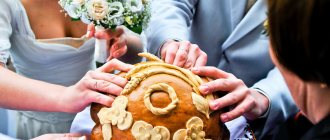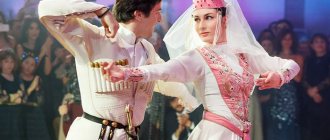Hospitality and tea drinking
Although the Uzbeks themselves dress rather sadly - black and shades of gray, they are very cheerful and love to joke. Hospitable, happy to share everything they have. Dastarkhan must be filled so that there is no free space left. There are fruits, berries, vegetables (especially melons and watermelons), flatbreads, cold appetizers, and not to mention sweets.
Since ancient times, a traveler passing by was supposed to be invited into the house and treated to bread and tea. The one who receives guests must be friendly and friendly, be able to skillfully serve food, and show equal respect to all guests. The custom of treating friends and neighbors with the first fruits from one’s garden is still alive.
The Japanese and Chinese have their own ritual of taking a tea drink; Uzbeks are also sensitive to this, starting and ending with tea when eating. Green tea is the most popular; black tea is drunk in Tashkent. They are consumed without sugar, but certain herbs and spices are added. The hosts first set the table, decorating it with various sweets and fruits. Then the bowls are placed and a kettle of freshly brewed tea is brought. The owner pours a little drink into the bowl, then returns it to the kettle - and so on 3 times. Finally, he fills the container halfway and serves it to the guest. To an uninitiated person, it seems that some kind of ritual is being performed, but in reality everything is much more prosaic. Dry tea leaves, after pouring boiling water, release their aroma too slowly, and pouring helps to mix them evenly and speeds up the process.
Briefly about the brewing process. The porcelain steamer is first heated, then dry leaves are poured in, and a little (about a quarter) of boiling water is added. Simmer for some time by steaming or in the oven. What's the hurry? This is the East. Then fill it halfway, leave it to steep, and add hot water again. It will take a few more minutes until it starts to pour. In some regions, milk is added to tea.
They do not top up the drink so that the guest does not get burned, but the main thing is that later he asks to add more, which they will do with pleasure, since the traditions of the Uzbek people require respect for the traveler and care for him. When bringing tea to a dear guest, they put their right hand to their heart as a sign of respect. Joke: the Uzbek is so greedy - he not only pours half the tea, but also clings to his heart!
Chaikhona (teahouse) is the same unshakable element of local traditions as tea. Social life is centered around mosques, bazaars and teahouses. In the teahouse, hiding from the scorching sun, people talk, relax, share news and have lunch. In addition to tea, you can order food, as well as wine or beer. Uzbekistan is a Muslim country where alcohol is legal.
Rules of conduct for Uzbeks
Uzbek customs require special behavior and adherence to traditions from representatives of the nationality. Similar to other Muslims, Uzbeks observe fasting, completely abstaining from alcohol, cigarettes and food until sunset. In family relations, there is a strict hierarchical system of subordination to the oldest representatives of the family. Every day in Uzbekistan, according to tradition, the prayer “namaz” is said five times.
Don't say no
Uzbeks and other peoples of the eastern part of the world are very polite and kind towards others. They never say “no” and agree to any proposal or request. The only clouding communication is the lack of an exact time frame in the response. Uzbek citizens will not rush to help you, even if they agree. Aggression is also not held in high esteem here, so they try to appease every angry person in every possible way and shower them with promises.
Women are seated at a separate table
The tradition of seating women at another table still remains in rural Uzbek settlements. In ancient times, the family home was divided into two parts: women's and men's, and from there came the customs of eating at different tables and dividing responsibilities into women's and men's. Contrary to such traditions, women in the family are treated with special respect and respect, both as mothers and as spouses. But they still demand that she fulfill household obligations, even if she brings money to the family or is engaged in scientific activities together with her husband.
Eating pilaf
Uzbek cuisine is heavy and fatty. The main ingredient is meat, usually very large pieces. This is served with delicious bread and pasta. It’s hard for vegetarians there, but as one traveler said: “Thank you to the Russians, thanks to whom salads from fresh and boiled vegetables appeared at the Uzbek table.” This is the kitchen of traveling people, so it had to provide energy for many hours.
The national dish of Uzbekistan is pilaf. It is more than food, it is an object of worship and part of the national culture. “You were born - you have pilaf, you got married - you have pilaf, you died - you have pilaf,” the locals joke. Rice, vegetables, a lot of meat, unique Uzbek spices, and the taste is piquantly diluted with raisins. It is served both for family dinners and celebrations. You can try pilaf everywhere, but every city has its own way to this dish. At the Plov Center restaurant, this dish is served with the addition of boiled eggs and pieces of horse sausage.
Eating morning pilaf is unusual for many foreigners. Men from the bride's side - elders, relatives, colleagues, as well as the groom and his friends - are invited to a festive breakfast on the day of the wedding ceremony. Men also cook it. The cauldron is placed outside on an open fire. The early breakfast (5-6am) is served in a friendly and pleasant environment. Then everyone disperses and meets at the wedding.
Local residents eat pilaf with their hands. It is served in such a way that it is convenient to take a piece of meat from a common dish and scoop up rice with it, put it in your mouth and eat it with a clove of garlic. At the family table, one large dish is served, from which everything is eaten, which emphasizes the unity of relatives. In restaurants, customers are served forks. But those who want to feel the traditions of Uzbekistan can feel the taste through their hands. A long time ago, when there were no napkins, people wiped their hands with their own robe after pilaf. It was believed that the fatter the clothes, the richer the person, because the poor usually ate pilaf without meat.
We create traditions for the family ourselves
There are more similarities than differences in mentality. In my family and his, elders are respected and any nation is respected. But since childhood, I have become accustomed to addressing my parents as “you,” and in my husband’s family they address me as “you.”
About the advantages of an international family
The biggest advantage of international families is beautiful children.
The children’s native language is Russian; they understand little Uzbek. But this does not prevent them from making friends with children who speak only Uzbek. They also study it at school.
Children love Uzbek dishes, they know holidays and our history.
Welcome Features
Greeting is also part of the traditions of Uzbekistan. It is impossible to imagine Uzbeks who met on the road and fled to their own affairs. You need to perform a certain ritual - not only say hello, but also sincerely take an interest in the affairs of your interlocutor in all details: how are things at home, how are the children, is the refrigerator full. The answer should be positive: thank Allah, everything is fine. It takes a lot of time, but it sounds more emotional when meeting women.
In Uzbekistan they wish good health to any person, even a stranger. Juniors always greet seniors, a rider on a horse is the first to greet a pedestrian, a person of a higher rank must be the first to show respect to his interlocutor. It's men's privilege to shake hands; women usually place their hands on their hearts and nod.
Uzbek brides: features of wedding dress
The traditional wedding attire of Uzbek brides deserves special attention. However, the bride always has the opportunity to choose a European dress for the celebration. The Svadebka.ws portal will tell you below what the national wedding attire should be.
The dress is made from khan-atlas, a type of silk fabric widely used in Uzbekistan. The bride usually wears silk harem pants under her dress. Over the wedding dress, a skillfully embroidered sleeveless vest, a silk robe or a velvet camisole embroidered with gold threads is worn.
Particular attention is paid to the bride's headdress. National Tiplya-kosh is a kokoshnik, decorated with a large number of pendants and openwork embroidery. The girl's face must be covered with a veil.
Mentality
It is impossible to briefly describe the manners of the local residents. It is not in Uzbek customs and traditions to participate in open conflicts and show aggression - they are accustomed to kindness and politeness in all situations. This feature of the national character and culture developed in the distant past: for centuries, Uzbeks were engaged in trade, and insulting the buyer did not meet the interests of the seller. Therefore, the request will not be directly refused and instant consent will not be given either, the traditional answer is: “Okay, okay.” It’s just not known when the promise will be fulfilled - the Uzbek is in no hurry to act and make decisions.
In marriage, a woman is not equal to a man. According to Sharia, a man can have up to 4 wives, although almost no one has used this right and is content with one woman. This practice was recently banned, and a law is being drafted to criminalize imams who perform nikah (religious marriages) for men who already have one wife. Before marriage, a girl cannot have intimate relationships, otherwise she will become “unclean” and no Uzbek will want her. In such cases, women usually marry Russians.
Children are raised strictly, the woman is largely subordinate to her husband and mother-in-law, and the last word always belongs to the man. The wife is respected as the keeper of the hearth, mother, spouse, but she must be submissive and take care of the housework. Even if she works equally with her husband (today an Uzbek woman can be a scientist and a businesswoman), this does not cancel the preparation of dinner for his arrival.
How to behave
When visiting sacred buildings (mosques, churches, synagogues), local customs must be unconditionally observed. Some mosques are not accessible to non-Muslims. Outside of large cities (Tashkent, Samarkand, Bukhara, Nukus), women should avoid clothing that emphasizes the figure, with bare elbows and knees.
According to the Constitution, Uzbekistan is a secular state, but Islamic culture is present in society. The province and the entire Fergana Valley are more Muslim than the country's major cities. This means that women traveling alone will find interest from Uzbek men. Uzbeks do not have the right to openly establish relationships with their girlfriends.
Kamila Kotlyarova, 37 years old, Uchkuduk, Tashkent, blogger, @kamilamom
About dating and starting a family
We met through music.
I sang, my husband was a musician, and we did musical projects together. They got married in 2005.
Both his and my parents are modern people.
They reacted positively to our choice. My husband is Russian.
We didn't have a traditional wedding. There was an evening that we thought out for ourselves.
We have three children, and we chose unusual names for them: Martin, Olivia and Daniel.
About the peculiarities of mentality
We create traditions for the family ourselves.
We are not based on national aspects. But there is one very common one: when we spend time together or with relatives, my husband cooks delicious Uzbek pilaf. I don't know how to cook like this.
Holidays
Religious
Uzbeks honor all Muslim religious holidays. The most significant are Ramadan Hayit and Kurban Bayram. Ramadan Hayit is a wonderful holiday of spiritual and moral purification.
National
Mustakillik or Independence Day is the biggest. Celebrated on September 1, the Festival takes place in the capital of Uzbekistan. Constitution Day, celebrated on December 8th. Day of Remembrance and Honorable Day, which, like in many other countries, is celebrated on May 9th.
Nowruz is another national holiday. Celebrated on March 21, it is a New Year's holiday in the east. Relatives and friends will definitely ask for forgiveness on this day and forgive others.
Family
A wedding is usually a huge event and can include up to 400 people. Both relatives and parents’ colleagues and bosses take part in the celebration. Compared to Europe, the earnings of an Uzbek family are negligible, so they collect money for such an event for several years, but the interesting thing is that the cost per person is only about 7 US dollars.
Events take place in large wedding houses 7 days a week. This is accompanied by a rich "frame", thousands of flowers, a wall with sculptures for photographing in front of it and many other variations. The feast consists of two parts. The first takes place in the morning, where the oldest people are usually invited to be treated to a festive national breakfast. These are simply “get-togethers” that take place in table conversations. In the evening the real dance party begins. Women dress up like "a million dollars." They only walk until midnight, then disperse.
The birth of a child is especially important for Uzbeks. For the sake of this event, the male father prepares morning pilaf, treats guests, accepts congratulations and gifts.
Traditions and customs of Uzbekistan
The traditions and customs of the Uzbek people have been formed over centuries. The Uzbek ethnic group is one of the most ancient ethnic groups that ever existed on the planet. In addition, this is the largest ethnic group in Central Asia. The original culture of the peoples of Uzbekistan was formed at the dawn of civilization, already in the 4th century BC. e. Compliance with customs and traditions has always been the duty of every person, regardless of his origin and social status. This is due to the fact that self-awareness and self-respect among the peoples of Central Asia are instilled by Islam.
It all starts with a greeting
Since ancient times, the peoples of Central Asia have developed a tradition - when meeting, Muslims must greet each other, even if they are not friends and even if there are hostile relations between them. Answering every greeting was considered a sign of good manners.
Who should have greeted whom first? It turns out that people riding on horseback were supposed to greet those walking, people occupying a higher position on the social ladder were supposed to be the first to greet people standing lower, gentlemen were supposed to greet their servants, and juniors were supposed to greet their elders. Well, if several people at the same time expressed a desire to greet one person, then this person had to respond to their greetings in such a way that it was clearly visible that his greeting applied to everyone at once.
Who should you not greet and under what circumstances? According to the instructions, one should not say hello, for example, in cases where someone was busy praying or reading the Koran, if a person was busy eating or was in a latrine, etc. And it was strictly forbidden to respond to greetings, and even more so to give greetings to ill-mannered, dishonest and cruel people.
Famous Uzbek hospitality
Eastern hospitality is not just a custom, it is a moral law that has come to us from time immemorial.
“Hospitality is higher than courage,” as the old proverb went. And these are not empty words. To refuse a guest a welcome, not to seat him at the table, not to treat him, or to receive him poorly - such lack of hospitality brought a grave shame not only on the family, but also on the entire clan. Hospitality could not be refused even to an enemy.
The laws of hospitality have survived to this day, having become a good tradition. Uzbek families are usually large families consisting of several generations. Respect and veneration for elders is another main tradition of the Uzbek people.
If you have never visited a traditional Uzbek family, then it is advisable for you to familiarize yourself with some rules of conduct.
So, you have been invited to visit. It would be impolite to refuse an invitation or arrive late. Once at the doorstep of the house, you need to say hello to the owners and other guests. You can only shake hands with men; it is better to do this with both hands or with your right hand, without squeezing your palm. During the handshake, it would be appropriate to traditionally inquire about health, ask how things are at home and at work. But it would be appropriate to shake hands with a woman only if she extends her hand to you first. Usually, it is customary to greet women and other guests who are sitting away from you by placing your hand to your heart and tilting your head slightly. And you can’t openly admire a woman’s beauty and show her all sorts of attention.
It is not customary to visit an Uzbek family empty-handed. Traditionally, guests bring sweets and souvenirs to the house. It is customary to take off your shoes when entering a house. There is an old custom according to which women should not sit at the same table with men, so as not to interfere with their conversation. But in our time, this custom has been preserved mainly in rural areas.
So, you are already a guest. The head of the family himself will take you to your assigned place among the other guests. The owner assigns the most respected guests a place at the table away from the entrance. When all the guests are gathered, the oldest person present at the table reads a short prayer with best wishes to the owners of the hospitable home. Then, according to tradition, the host invites the guests to drink a bowl of tea. And only after all the necessary ceremonies have been observed, guests can start eating.
Now a little about how to behave at the table. If during a meal you need to take an object with your hand or pass something to a guest sitting next to you, use only your right hand for these purposes. But you should not point with the index finger of your right hand at objects or people.
Tea party
Traditionally, any meal in an Uzbek family begins and ends with tea. The tea ceremony occupies a special place in the life of the residents of Uzbekistan. The owner or hostess of the house should first of all brew tea and treat guests at the table with this amazing drink. Various sweets and fruits are served on the table, and tea is brewed in small teapots and poured into small bowls. Before serving tea to guests, the host or hostess pours tea into the bowl three times and pours it back into the teapot. This ancient custom was not invented by chance - this way the tea is brewed quickly, and the tea poured into bowls will be the same. And don’t be surprised if the owner pours you an incomplete bowl. This is a traditional element of hospitality. The more honored the guest, the less tea is poured into his bowl.
How is such a strange custom explained? It’s all very simple - a guest, having sipped tea from his half-empty bowl, again and again turns to the owners of the house for more, and it is precisely such repeated appeals to the owners with an empty bowl that are considered as a tribute to the hospitable family. In addition, if the bowl is no more than half filled with tea, it is comfortable to hold in your hand, the guest does not risk burning his fingers with hot tea, and the hosts are happy to demonstrate their hospitality by their willingness to once again look after the guest.
Are there cases when a guest is poured a bowl of tea full to the brim? In the old days, it was customary to do this in those exceptional cases when an unwanted guest came to the house. The owner handed him a bowl filled to the very brim with hot tea, in such a diplomatic way letting the guest know that he was persona non grata and they did not want to communicate with him. The guest, understanding the host's hint, drank tea and left. But this custom has remained far in the past; nowadays it is no longer observed.
The traditional place for tea drinking in Uzbekistan is chaikhona (teahouse). It is customary to choose a place for a teahouse closer to the water, under the crowns of spreading shady trees. The traditional interior of a teahouse consists of low sofas, which are covered with carpets, and the same low tables. The main place in the interior is given to the hearth, over which water is boiled and food is prepared. There are teapots near the fireplace. The atmosphere of the teahouse is cozy and unique. Social life is in full swing here; visitors to the teahouse not only drink tea, eat food and relax, but also share the latest news with each other, discuss pressing life problems, and have philosophical conversations.
Uzbek holidays
The Uzbek people love and know how to celebrate. Weddings, anniversaries, national holidays - any festive event in Uzbekistan is fun, hospitable with a large number of guests with an abundance of delicious national dishes to the sounds of national instruments and, according to tradition, fiery dances.
The main national holiday is Independence Day, which is solemnly celebrated on September 1. Two more significant holidays are Constitution Day, celebrated on December 8, and Remembrance and Honors Day, which, as in many other countries, is celebrated on May 9. Some of the most significant Muslim holidays are Ramadan Khayit and Kurban Khayit. The holiday of Ramadan Hayit is a wonderful holiday of spiritual and moral purification. According to Islamic law, this holiday begins on the 9th month of the Muslim year of Hijri after the end of 30 days of fasting. Kurban Khayit is one of the most important Muslim holidays. On this day, believers perform the required rituals, and then receive guests or go to visit themselves and engage in charity work.
Assalom, Nowruz or Happy New Year!
The word “Navruz” is translated as “new day”. The holiday is celebrated on March 21. It is during this spring season that nature finally wakes up after hibernation, symbolizing the beginning of a new year with its renewal. Navruz is an ancient holiday; according to historians, it was celebrated 3,000 years ago.
How is Nowruz celebrated these days? If the celebration of the European New Year begins at midnight, then Navruz is celebrated during the day. Like the New Year, Navruz is a family holiday; it is also customary to celebrate it with family and friends. Following the main day of Navruz celebration - March 21, there are 13 more holiday days, when it is customary to invite guests, as well as go on visits, visit relatives, friends and just good acquaintances. On holidays, a large number of young fruit tree seedlings are traditionally planted in parks and gardens.
Residents of cities and villages in Uzbekistan are preparing for Navruz in advance. In each mahalla (neighboring community), hashars are held (joint work akin to a subbotnik). People, united by the common task of preparing for the holiday, bring the city or village into a proper festive appearance.
And now the long-awaited day of March 21st comes. The festive fun begins. In every mahalla, festive tables are set, amber festive pilaf is prepared in huge cauldrons, music, songs, dances! This is such popular fun!
Try sumalak!
Navruz has been considered a special holiday since ancient times. Therefore, the table should be set in a particularly generous way. There is such a sign - the richer the table, the richer the whole coming year will be. The holiday menu is of great importance. On the day of Navruz, the main festive dishes are pilaf, shurpa and samsa with the first spring greens. There should also be a variety of snacks, sweets and fruits on the table. But the highlight of the program on this day is a plate of sprouted wheat! This dish should definitely be on every holiday table.
The main holiday delicacy, sumalak, is prepared from sprouted wheat grains. Sumalak is prepared in a special way, this is a real ritual in which only women take part. Sumalak takes a long time to prepare, over the course of a whole day. Women, taking turns, slowly stir sprouted wheat grains in a huge cauldron, which, thanks to their efforts, gradually turn into a thick, sticky brown mass. During this event, women sing folk songs about spring and the Navruz holiday. During stirring, interesting sounds are heard in the cauldron. These are small pebbles or nuts hitting each other, which, thoroughly washed, are specially placed on the bottom of the cauldron at the very beginning of preparing sumalak. This is necessary so that the sumalak does not burn during cooking. Well, if such a pebble or nut ends up in your bowl of sumalak, rejoice, the whole year will be successful and happy for you!
Read more about the Navruz holiday >>>
Kupkari
The popular ancient national game kupkari (ulok, buzkashi) is associated with the celebration of Navruz. This is a game of truly strong and brave men. Riding on dashing horses, the players at full gallop try to take the young lamb from each other.
They prepare for the game seriously and in advance. You need to think through everything down to the smallest detail. First you need to choose the right horse, which should be short, hardy and fast. Why are short horses preferred? There is a logical explanation for this - in the midst of this gambling and exciting game, the lamb often falls out of the hands of the players and the rider has to hang from the horse all the way to the ground in order to pick up the lamb again. The next step in preparing for the game is choosing clothes. Kupkari participants usually choose a quilted cotton robe and equally thick quilted trousers. This choice is due to the fact that during the competition the opponents hit each other with a whip, which is allowed by the rules of the game, and cotton clothing is good protection from blows.
And now comes the long-awaited moment of the game. All the horsemen line up in one line and eagerly wait for one of the respected men to throw a lamb into the center of the circle. And as soon as the animal is in the center of the circle, the riders rush forward. The goal of the game is to snatch the lamb from your opponent’s hands and, with this trophy, ride to the finish line, leaving your opponents far behind. The finishing line can be an ordinary pillar dug into the ground. Clouds of dust, snoring horses, intense passions - this truly expressive spectacle evokes a storm of emotions not only among the players competing with each other, but also among numerous spectators.
The main prize is awarded to the winner by respected elders. At the end of the game, participants will enjoy a festive lunch.
Rituals of the Uzbek people
Each of the peoples inhabiting our planet has its own rituals, which have been formed over centuries. The rituals of the Uzbek people, based on the rich cultural heritage of their ancestors, have come into modern life, preserving their originality and diversity. Rituals play a special role in the life of Uzbeks. For example, such joyful moments of life as the birth and raising of children, engagement, and wedding are accompanied by unusually colorful ancient rituals.
Beshik-tuyi
And here is a joyful and important event - a new person was born! In an Uzbek family, the birth of a baby is accompanied by the ancient ritual festival “Beshik Tuyi” - “Wooden Cradle”. This ceremony is usually performed on the seventh, ninth, eleventh or fortieth day of the child’s birth. On the day of the ceremony, relatives from the wife’s side bring a richly decorated “beshik” cradle and the necessary accessories for the child, as well as many different sweets, traditional Uzbek flatbreads and toys for the baby, which are wrapped in a tablecloth - dastarkhan. The sounds of karnaya, surnaya and tambourine announce the beginning of the ritual. Many guests gather in the house and are taken to a festive table laden with rich treats. And while the guests are eating, enjoying the musicians playing, celebrating and having fun, the elderly women in the children's room perform the ritual of first swaddling the baby and putting him in the beshik. At the end of the ceremony, a viewing party for the child is traditionally held. Guests enter the children's room, admire the baby and shower the beshik with parvarda, navat and other sweets; according to the ritual, this is done so that the child's life is joyful and prosperous.
Khatna-kilish
The baby has grown up. Now he has to go through a very important ritual for him: khatna-kilish or sunnat thuya. This is a very ancient Uzbek circumcision rite, sanctified by Islam. It is performed on boys aged three to nine years. This ritual is also popularly called a “wedding.” Parents begin preparing for the wedding from the very birth of the child; relatives and neighbors also take part in preparing wedding gifts. Before the ceremony, the Koran is read in the presence of the imam from the mosque, relatives and honorary elders of the makhali. After reading suras from the Koran, the elders bless the boy and give him gifts. After this, the festive table is set and the ceremony itself begins - the big “wedding”. At the end of the ceremony, the guests congratulate the boy, showering him with money and sweets. And here is the culminating moment - a young stallion, decorated with elegant ribbons and rich harness, is brought into the center of the celebration. With wishes to grow up to be a powerful and brave horseman, the boy is seated on a horse. And at the end of the ritual, a holiday begins with abundant food, music, and dancing.
Fatiha-tuy
The son has grown up, matured, reached adulthood - it’s time to start his own family. According to tradition, parents themselves choose a bride for their son, and matchmakers help them in this. They treat the choice of a bride with all responsibility, asking in detail about her family and getting to know the girl’s relatives. All! The choice is made! The day of engagement comes - “fatiha-tuy”. On this day, guests gather in the house of the betrothed girl, among whom are respectable old men and the chairman of the mahalla. The matchmakers state the purpose of their visit, after which the “non sindirish” ritual is performed, which literally means “breaking a cake.” After performing this interesting ancient rite, the newlyweds are considered engaged, and a wedding day is set. The bride's relatives generously give gifts to the groom's relatives and matchmakers - they give each of them a dastarkhan with two flatbreads and sweets, and also give gifts to the groom and his parents. From the moment of engagement, preparations for the wedding begin.
Oh, this wedding!
In the life of the Uzbek people, a wedding is an extremely important significant event. The wedding is celebrated especially solemnly, with the obligatory observance of a number of wedding rituals. The wedding day begins with pilaf. On this day, a wedding pilaf is held in the houses of the bride and groom, and the pilaf for the bride’s house is prepared in the groom’s house. The marriage in the registry office takes place after the imam of the mosque reads the wedding prayer to the newlyweds - “Khutbai Nikoh” and declares them husband and wife before God. Before the wedding begins, the bride and groom put on wedding clothes - sarpo. The central event of the wedding is the ceremony of farewell to the parents, which is held before the bride, accompanied by her friends, leaves her father’s house and goes to the groom’s house. As soon as the bride crosses the threshold of the groom's house, the wedding celebration begins. Numerous guests gather at the festive table. The number of guests of two hundred or even three hundred people at a traditional Uzbek wedding is quite common. The celebration is fun, bright and fiery. At the end of the wedding, another ancient ritual is carried out - the ransom of the bride, which takes place in a room specially designated for the newlyweds. The groom accompanies the bride to the door of the room, where she is usually met by her close friend “yanga”. In the room, the bride changes clothes and hides behind a special “gushanga” curtain. Accompanied by friends, the groom enters the room, where he is offered to give a ransom for the bride. Bargaining begins, as a result of which the groom symbolically buys the bride from the “yanga”. At the end of this ceremony, the bride and groom remain alone in the room for the whole night.
The next morning after the wedding, the “Kelin Salom” ritual is performed. This ceremony signifies the acceptance of the bride into a new family. Parents, relatives and friends of the groom gather in the courtyard, present the bride with gifts and bless her. The bride, in turn, greets everyone, bowing low. From this moment family life begins.
Morning pilaf
In what cases is pilaf prepared in the morning? The ancient ritual of morning pilaf is not only a festive, but also a funeral pilaf, which in both cases is served only by men. The preparation of morning pilaf begins in the evening, with the ritual of chopping carrots - “sabzi tugrar”. The morning pilaf itself is prepared at the end of the morning prayer - “bomdod namozi”. It is the prayer participants who become the first to taste freshly prepared morning pilaf. The beginning of the morning pilaf is announced by the sounds of karnai and surnai. Guests are seated at the tables and, having performed the ritual of wishes - fotiha, begin the meal. First, flat cakes and tea are served on the table, then pilaf in large lyagans, one lyagan is designed for two people. At the end of the meal, the Fotiha ritual is performed again. At the end of the morning pilaf, guests of honor are usually presented with national men's robes - chapans.
Mahalla
The neighboring community - mahalla - always takes an active part in all the main events of the Uzbek family. The principle of mahalla is independence and self-government for the purpose of mutual assistance. Possessing thousands of years of experience in doing business, the Uzbek mahalla is still the center of family, household and religious rituals. The community is the custodian of the culture and traditions of the Uzbek people. But mahalla is not just a mutual aid society; it also successfully performs educational functions. Generation after generation grows up under the direct supervision of the entire community. Children raised in makhalla are raised in the spirit of respect for elders.
Hashar
In any mahalla there is a wonderful ancient tradition of mutual assistance - hashar. As they say, throughout the world, mahalla residents voluntarily and selflessly help each other when necessary. You need to build a house, improve a street or area, organize a morning pilaf - hashar always comes to the rescue.
Both in sorrow and in joy, residents of the mahalla try to stick together. As a rule, no one refuses when everyone is notified about hashar. People prepare for this event together, they also work together and harmoniously, managing to complete a large amount of necessary work in one calendar day. And then they also have lunch or dinner together. A wonderful oriental tradition!
Uzbek national clothes
Uzbek national clothing has original and unique features, testifying to the rich cultural traditions of the Uzbek people, their way of life, rituals and traditions. Of course, in cities, the majority of the population, following the trends of the time, wears European clothes, but in villages the main trends of traditional Uzbek clothing are still preserved.
In all centuries, people loved to dress beautifully, because it is clothing that perfectly emphasizes a person’s individuality. Everyday men's clothing in Uzbekistan was a traditional shirt - kuylak, and among residents of the Fergana and Tashkent regions, an open shirt - yakhtak - was common. Both of these shirts were made from cotton fabric. Sometimes the edges of the collar of a shirt were trimmed with braid - jiyak.
Another accessory of a man's suit were pants - ishton. They were of the simplest, uncomplicated cut, wide at the top and tapering at the bottom, without buttons, slits, or even pockets.
The men's suit was complemented by a robe - chapan. The robes were made of striped fabric with vertical slits on the floors, and they were trimmed with woven braid. There were no buttons on the robe; the floors of the robe were connected by two ties attached in the chest area. Depending on the time of year, robes were light without lining, more insulated with a thin lining, and winter, insulated with cotton wool.
The clothes of noble people were decorated with gold embroidery. Robes, skullcaps and even shoes were embroidered with gold thread. Nowadays, details of a men's wedding suit also include a robe embroidered with gold - a parchon and a turban made of silver or gold brocade.
A square scarf made of cotton or silk fabric, folded at an angle, called belbog, was also a common attribute of national men's clothing. Belbog was tied around the waist, it was usually of a bright color and stood out against the usually dark men's clothing.
According to the laws of Islam, believers were forbidden to leave the house with their heads uncovered. This is how another element of men’s costume appeared - the kuloh headdress or skullcap - duppy. The most common men's skullcap is the Chust skullcap of the Fergana Valley. It has a strict, but at the same time very interesting decorative appearance - an ornament in the form of kalampir pepper pods is embroidered on a black background with white threads, and sixteen patterned arches are arranged in a row along the edge. Skullcaps made of velvet or cotton fabric in black, blue or dark green were and remain popular in Tashkent to this day. But in Khorezm they prefer hats made of sheepskin as headwear.
The traditional clothing of the fair sex living in Uzbekistan is kuylak dresses and lozim trousers. The dresses were long, straight, but sometimes widening at the bottom. The sleeves are also long, covering the wrist. Later, at the end of the nineteenth century, the dresses were somewhat modernized - their cut appeared with a cut-off yoke, a stand-up collar and cuffs on the sleeves. Dresses made of bright silk and the famous khan-atlas have survived to this day.
Bloomers were an integral part of women's clothing and have reached the present day. These are pants that are wide at the top and tapered at the bottom and are worn under a dress. Sometimes the bottom of the trousers is trimmed with braid - jiyak.
The outer national clothing, just like men, was a robe - mursak. This robe was made long in the form of a tunic, sometimes quilted with cotton wool. Women also wore a tun chapan robe, similar in cut to men's, as outerwear. In the nineteenth century, a camisole or kamzur appeared in the women's wardrobe. At the same time, vests - nimcha - came into fashion.
After the abolition of the burqa in the twenties of the last century, Uzbek women began to use a headscarf as a headdress. Sometimes the headdress consisted not of one, but of two scarves - one, folded diagonally, was worn as a headband, and the second was thrown over the head. Scarves were sometimes decorated with embroidery. By the beginning of the twentieth century, duppy skullcaps with embroidery with gold thread or silk became widespread.
What woman doesn't love jewelry? According to tradition, gold and silver jewelry was an addition to the national costume of an Uzbek woman, regardless of age. These include rings with natural stones, bracelets, and earrings with dome-shaped pendants. Necklaces made of coins or beads made of coral served as decorations for the neck. All decorations were real works of art.
Author of the article: Yanick Lasko
Rituals of the Uzbek people
Islam plays a big role in the social and family life of Uzbeks. Five times a day, facing Mecca, one should perform namaz. During the month of Ramadan, observe strict fasting (do not drink, do not smoke, and do not eat until sunset). Give a portion of your income (zakat) to the poor or to charity. Unlike other Muslims, who are required to make a hajj (pilgrimage to Mecca), Uzbeks can replace it by visiting sacred places on their territory (mazars).
A special role is played by rituals associated with the birth and raising of children - Beshik-tui (first swaddling), Khatna-kilish (circumcision), with marriage - Fatiha-tui (engagement), with cooking. In many ways, they represent an interweaving of Islamic rituals with ancient magical practices.
Uzbeks also believe that turning bread upside down will bring bad luck. This is not the only curiosity associated with bread - according to ancient tradition, a family member who is going to travel must take a bite of a small Uzbek bread. The remaining bread is then hidden and stored until the traveler returns home.
Before marriage, the families of young people determine how the children invest in the future - if the groom buys an apartment, then the bride buys furniture and utensils. The size of the dowry and bride price are negotiated.
The search for a future spouse and the matchmaking process
An Uzbek wedding differs from a Russian one in its rituals. The bride is the girl who has a special character. Her search is carried out by professionals in the form of a grandmother, mother or older sister.
When selecting a candidate, the situation in the girl’s family is taken into account. Priority is given to those women who grew up in a full-fledged and prosperous family. Parents should be honored and respected. The key points when choosing a future spouse are social status and upbringing. Since ancient times, it was believed that in order to strengthen relationships and raise the social status of the family, the groom was tied by marriage to the family that has a high status.
A man can start looking for his future wife himself. Only love and passion take last place. Despite this, the final choice remains with the man’s parents.
If the choice of son suits the elders, then they begin the matchmaking process. The matchmakers go to the future wife's home. The date is set in advance so that the bride's family can prepare for the event. After the matchmakers have arrived, they are seated at a table, at which a conversation takes place between the elders on various topics. While drinking tea, a young girl takes care not only of her betrothed, but also of the guests. She must ensure that tea is always poured and that the invited guests remain happy and fed.
During the conversation, matchmakers pay attention to several things in the form of:
- home decoration;
- tidiness and order;
- the bride's good behavior;
- meekness and laconicism;
- ability to manage housework;
- relations between parents;
- the relationship of elders to their daughter;
- relations with guests.
The decision about the wedding is made only after the third visit. Then the elders of the future wife share the cake. This sign symbolizes a positive decision to give your daughter in marriage. First, a traditional engagement is held, which is called Fatiha-Tui. The celebration is characterized by pomp. Many guests are invited. The girl is given gifts and sweets by the groom. Then the Uzbek wedding takes place.
Uzbek bride's holiday - Kiz Osh
It is believed that an eastern wife should have a large dowry. As soon as a girl is born into an Uzbek family, the mother and father prepare to prepare a dowry. Sometimes this process begins at age 6. According to established traditions, the costs of the wedding celebration fall on the shoulders of the groom's parents. But in the modern world they are often divided between two families.
Before the wedding, a celebration takes place in the bride's house. Only representatives of the weaker sex gather there. This event is also called a bachelorette party. It is bright and fun. Girls can have fun, dance and sing songs. There are a lot of sweets on the table. Another tradition is the bride giving things to her bridesmaids.










